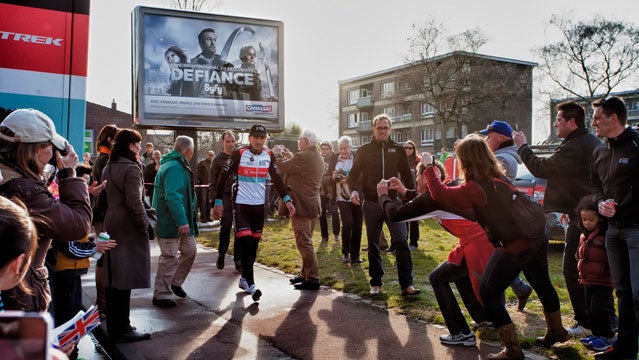If you didn’t watch Paris-Roubaix on Sunday, you missed one of the finest races of the 2013 season and one of the most exciting Spring Classics in recent history.
 Cancellara angles for the win in second wheel on the Velodrome.
Cancellara angles for the win in second wheel on the Velodrome.The big Swiss’s place atop the podium might paint the 2013 Roubaix as an insipid procession to a foregone result, but the footage of favorite Fabian Cancellara collapsed and gasping for air on the grassy field in the velodrome illustrated the monumental battle he fought to get there. It took Spartacus every last meter of this 254.5-kilometer classic to slay his competition and produce what is arguably the most memorable of his three career wins at Roubaix. With the triumph, Cancellara became one of just nine racers in the event’s 111 starts to win Roubaix at least three times. He also moved alongside Tom Boonen as the only other rider in history to twice secure the Tour of Flanders and Paris-Roubaix double in a single season.
The stats—though impressive—aren’t the end of the story. Since it debuted in 1896, Paris-Roubaix has earned a reputation as one of the most difficult and sublime races on the cycling calendar. Part of the mystique comes from the often wicked weather (notably absent in this year’s event), with cold, rain, and wind crippling riders and felling the hopes of many would-be victors. And while the Roubaix course is ice-rink flat, the race gets its difficulty from the 27 sections over ancient cobblestone roads, which total 52 kilometers or 20 percent of the entire race. These rutted passages jackhammer the charging riders, numbing hands, compressing spines, and often causing spectacular crashes. I’ve ridden some of these cobbles and can confirm that they would be jarring on a mountain bike, which is why the race has given rise to specially adapted bikes, wheels, and tires. Adaptations aside, it’s inspirational verging on mind-blowing to see racers blast through such a long and brutal course at incredible speed. (The speed record of 28.042 miles per hour was set during the 165-mile 1964 edition.)
That Cancellara entered the 2013 Roubaix as the odds-on favorite and still managed to win is a feat unto itself. , he was clearly the strongest rider in the race but had to settle for second place because all of his competition refused to collaborate for fear of losing to him. This year was different as the Swiss and his Radioshack-Nissan-Trek team played perfect tactics by keeping breaks to under two minutes until the last 50 kilometers, at which point Cancellara used his overwhelming power and experience to reel in and control the moves himself. He looked like he might be in trouble in the last 20 kilometers, when Omega-Pharma seemed to have the upper hand with two of four racers in the lead group. But Stijn Vandenbergh collided with a fan and crashed heavily with 16 kilometers to go, and Zdenek Stybar bobbled on the rough roads and lost the wheel shortly thereafter, leaving only Cancellara and young Belgian sensation Sep Vanmarcke at the head of the race.
Cancellara tried to dispatch Vanmarcke with one of his trademark surges in the closing kilometers, but the youngster hung tough and the two entered the velodrome together for the final 1.5 laps. Cancellara outmaneuvered the Belgian with a track stand high on the final banked turn and then outkicked him to win by less than a bike length. Ecstasy colored Cancellara’s face as he crossed the line, but it quickly turned to agony as he collapsed on the infield wheezing for air.
At a press conference later, he said it was the hardest he’d ever had to work for a win. “I think the hands are okay,” he said. “It’s just the whole rest of the body is … how I can say? Flat fucked.”
This is how racing is supposed to be: hard as hell, fast, and tactical at the same time, and suspenseful to the finish. Cancellara went into this Roubaix as one of the finest classics racers of his generation, and he rides away an even bigger legend. He proved that not only can he win solo with overwhelming shows of power, as he did at the Tour of Flanders last week, but he can also win on wits.
The only thing that would have made for a better race is if it had included Boonen, . Cancellara now has six career wins in the Monuments (three at Roubaix, two at Flanders, and one Milan-San Remo), an impressive haul but one that falls short of Boonen’s plunder (four at Roubaix and three at Flanders). After the race, the pundits were already looking to 2014 for the match-up, but Cancellara was having none of it. “I’m happy with the result and happy with the double,” he said. “But now I’m most happy to have a rest and to have a holiday.”


